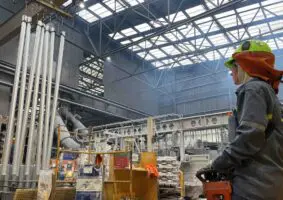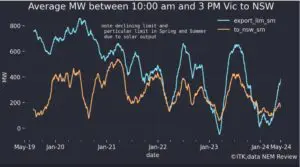There’s about $3.5 trillion of revenue each year from the “mine mouth” value of global coal, gas and oil sales. The biggest part of that dollar value is oil. All of that has to go away and about half of it needs to be gone in the next 12 years.
Clearly, that isn’t going to be easy and clearly there will be lots of vested interests who will care more about this year’s revenue than the future their children and grandchildren will face. It was ever thus.
Whether you think that requirement will or will not be met it seems clear that global policy will move in that direction.
Federal election odds – The Federal Government matters to electricity and decarbonisation
During the week the Coalition improved in betting odds and the ALP weakened. Last Monday marked the peak of ALP favouritism to date. We see the betting odds as representing the probability of what punters think will happen compared to the rewards of being right or wrong in that assumption.
They do not directly measure voting intention as an opinion poll does but rather an incentivized consensus of what the punting public thinks will happen. This table will only show up for a few more weeks. Although interesting, its accuracy is far from proved.

This Washington Post article suggests betting markets may not even be as good as opinion polls, at least in the US.
For what it’s worth I think the change was due to Morrison being a good campaigner and keeping the ugly (to me) largely unpopular, as shown in Victoria, hard right of the Coalition well away from the news in the hope that voters will have forgotten or forgiven them by May 18.
Politics are important to decarbonization and electricity policy. We repeat that other than the toothless “safeguard” mechanism, the Coalition has zero decarbonization policy.
The Coalition does have a series of electricity policies but frankly I don’t spend any time on them as they are anti business, anti good government (ie picking winners), piecemeal and developed without any regard for industry management (eg what the ESB, AEMO, AEMC and AER) are doing.
By contrast, the ALP has a strong suite of policies although they will not deliver anything like 45% decarbonization by 2030. Laughable statements by the current Prime Minister about the cost of the policy simply reflect that a mechanism to connect electricity achievement with the broader economy has not yet been developed.
What this really shows, to me, is that the Prime Minister has zero interest in the topic other than scoring points with the even less informed mainstream media. Someone that was interested would be more forward-looking and be thinking about how to manage the decarbonization process.
The work I did last week on EVs showed that policy won’t deliver more than about 25 million tonnes of abatement even if 50% of all car trips were electric, never mind the 50% of new car sales which the policy has as a goal.
If the Coalition were serious about the topic they would be thinking about the EITE sector and how it’s gong to cope.
The market action

Demand was soft as might be expected with Easter and a mild Autumn. Spot prices moderated significantly from a few weeks ago but are still modestly above last year. Gas prices are sky high. Futures traders must be on holiday.

Coal prices have recovered from recent lows. This is good for renewables. Optimism about the USA economy has also increased as measured by the increase in the USA 10 year bond rate.
The next news I look for internationally is the annual reports of the Chinese Independent Power Producers due by the end of April. This will give insight into volumes, prices and profitability of Chinese thermal generation.
A new table summarizing generation by fuel
Despite the work load, ITK hopes to keep up to date the generation by fuel table and chart shown below.

Of interest is rooftop solar is now 9% of generation in South Australia. Our table takes no direct account of exports or imports or losses. Equally of interest is the decline in Tasmanian Hydro production, probably more a short term feature but clearly contributes to price action. Hydro generally is well down.

Volumes

Base Load Futures, $MWh


Gas Prices











